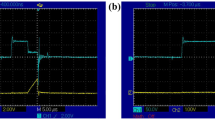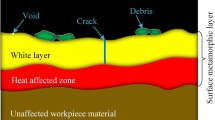Abstract
In electrical discharge machining (EDM), it is a much more effective method to improve working characteristics by changing the input process of pulse energy. However, it has not been investigated enough whether pulse form is the most adequate or not. In this study, the effect of superimposed pulse current waveform and its parameter on surface integrity was investigated. The surface topography, roughness, microstructure, white layer thickness, and residual stress were analyzed and discussed. Moreover, the material removal rate was also tested and compared. The results show that with the backward movement of the superimposed pulse current, the material removal rate and surface roughness decrease, while the white layer thickness, residual stress, and surface defects increase. The current waveform has little influence on microstructure. Under the same pulse discharge energy and pulse-on time, the samples processed by superimposed pulse current waveform instead of rectangular current waveform can obtain a thinner white layer, lower residual stress, fewer surface defects, and high surface roughness. With the increase of superimposed pulse-on time and current, the surface integrity becomes worse due to the increase of pulse energy. This paper provides a guide to the development and selection of EDM discharge current waveforms in EDM.















Similar content being viewed by others
Availability of data and materials
All the data and materials of this work are available to the readers, according to the magazine policies.
References
Zhou M, Mu X, He L, Ye Q (2019) Improving EDM performance by adapting gap servo-voltage to machining state. J Manuf Process 37:101–113. https://doi.org/10.1016/j.jmapro.2018.11.013
Hardik B, Pandey PM (2018) Experimental investigations to evaluate the effect of magnetic field on the performance of air and argon gas assisted EDM processes. J Manuf Process 34:356–373. https://doi.org/10.1016/j.jmapro.2018.06.026
Ishfaq K, Sana M, Ashraf WM, Dua V (2023) Sustainable EDM of Inconel 600 in Cu-mixed biodegradable dielectrics: modelling and optimizing the process by artificial neural network for supporting net-zero from industry. J Clean Prod 421:138388. https://doi.org/10.1016/j.jclepro.2023.138388
Chen N, Kong L, Lei W, Qiu R (2023) Experimental study on EDM of CFRP based on graphene aqueous solution. Mater Manuf Process 38:1180–1189. https://doi.org/10.1080/10426914.2023.2165674
Wang G, Han F, Zhu L (2022) Influence of energy input process on the white layer and residual stress in electrical discharge machining. Int J Adv Manuf Tech 119:4925–4937. https://doi.org/10.1007/s00170-022-08657-8
Yue X, Yang X, Li Q, Li X (2020) Novel methods for high-speed observation of material removal and molten pool movement in EDM. Precis Eng 66:295–305. https://doi.org/10.1016/j.precisioneng.2020.07.009
Mishra BP, Routara BC (2020) Evaluation of technical feasibility and environmental impact of Calophyllum inophyllum (Polanga) oil based bio-dielectric fluid for green EDM. Measurement 159:107744. https://doi.org/10.1016/j.measurement.2020.107744
Jahan MP, Rahman M, Wong YS (2011) A review on the conventional and micro-electrodischarge machining of tungsten carbide. Int J Mach Tool Manu 51(12):837–858. https://doi.org/10.1016/j.ijmachtools.2011.08.016
Liao Z, Monaca AL, Murray JW, Speidel A, Ushmaev D, Clare A, Axinte D, M’Saoubi R (2021) Surface integrity in metal machining-Part I: fundamentals of surface characteristics and formation mechanisms. Int J Mach Tool Manu 162:103687. https://doi.org/10.1016/j.ijmachtools.2020.103687
Monaca AL, Murray JW, Liao Z, Speidel A, Robles-Linares JA, Axinte DA, Hardy MC, Clare AT (2021) Surface integrity in metal machining-Part II: functional performance[J]. Int J Mach Tool Manu 164:103718. https://doi.org/10.1016/j.ijmachtools.2021.103718
Wang G, Han F (2021) A comparative study on the surface integrity of single-step and multi-step sequential machining in electric discharge machining. Int J Adv Manuf Tech 114:1803–1817. https://doi.org/10.1007/s00170-021-06947-1
Aigner R, Pusterhofer S, Pomberger S, Leitner M, Stoschka M (2019) A probabilistic Kitagawa-Takahashi diagram for fatigue strength assessment of cast aluminium alloys. Mat Sci Eng A-Struct 745:326–334. https://doi.org/10.1016/j.msea.2018.12.108
Cox A, Herbert S, Villain-Chastre JP, Turner S, Jackson M (2019) The effect of machining and induced surface deformation on the fatigue performance of a high strength metastable β titanium alloy. Int J Fatigue 124:26–33. https://doi.org/10.1016/j.ijfatigue.2019.02.033
Herbert C, Axinte DA, Hardy M et al (2014) Influence of surface anomalies following hole making operations on the fatigue performance for a nickel-based superalloy. J Manuf Sci Eng 136:051016. https://doi.org/10.1115/1.4027619
Ghanem F, Sidhom H, Braham C, Fitzpatrick ME (2002) Effect of near-surface residual stress and microstructure modification from machining on the fatigue endurance of a tool steel. J Mater Eng Perform 11:631–639. https://doi.org/10.1361/105994902770343629
de Jesus AMP, Ramos GFS, Gomes VMG, Marques MJ, de Figueiredo MAV, Marafona JDR (2020) Comparison between EDM and grinding machining on fatigue behaviour of AISI D2 tool steel. Int J Fatigue 139:105742. https://doi.org/10.1016/j.ijfatigue.2020.105742
Wu KL, Yan BH, Huang FY, Chen SC (2005) Improvement of surface finish on SKD steel using electro-discharge machining with aluminum and surfactant added dielectric. Int J Mach Tool Manu 45:1195–1201. https://doi.org/10.1016/j.ijmachtools.2004.12.005
Gostimirovic M, Kovac P, Sekulic M, Skoric B (2012) Influence of discharge energy on machining characteristics in EDM. J Mech Sci Technol 26:173–179. https://doi.org/10.1007/s12206-011-0922-x
Rebelo JC, Dias AM, Kremer D, Lebrun JL (1998) Influence of EDM pulse energy on the surface integrity of martensitic steels. J Mater Process Tech 84:90–96. https://doi.org/10.1016/S0924-0136(98)00082-X
Gostimirovic M, Pucovsky V, Sekulic M, Radovanovic M, Madic M (2018) Evolutionary multi-objective optimization of energy efficiency in electrical discharge machining. J Mech Sci Technol 32:4775–4785. https://doi.org/10.1007/s12206-018-0925-y
Lee HT, Hsu FC, Tai TY (2004) Study of surface integrity using the small area EDM process with a copper-tungsten electrode. Mater Sci Eng A Struct 364:346–356. https://doi.org/10.1016/j.msea.2003.08.046
Amorim FL, Weingaertner WL (2005) The influence of generator actuation mode and process parameters on the performance of finish EDM of a tool steel. J Mater Process Tech 166:411–416. https://doi.org/10.1016/j.jmatprotec.2004.08.026
Bozkurt B, Gadalla AM, Eubank PT (1996) Simulation of erosions in a single discharge EDM process. Mater Manuf Process 11:555–563. https://doi.org/10.1080/10426919608947508
Li XS, Cai AH, Zeng JJ (2012) Effect of EDM conditions on surface residual stress of Cr12MoV steel. Mater Sci Forum 697:171–175. https://doi.org/10.4028/www.scientific.net/MSF.697-698.171
Ekmekci B (2009) White layer composition, heat treatment, and crack formation in electric discharge machining process. Metall Mater Trans B 40:70–81. https://doi.org/10.1007/s11663-008-9220-0
Zhang Y, Liu Y, Ji R, Cai B (2011) Study of the recast layer of a surface machined by sinking electrical discharge machining using water-in-oil emulsion as dielectric. Appl Surf Sci 257:5989–5997. https://doi.org/10.1016/j.apsusc.2011.01.083
Pecas P, Henriques E (2008) Electrical discharge machining using simple and powder-mixed dielectric: the effect of the electrode area in the surface roughness and topography. J Mater Process Tech 200:250–258. https://doi.org/10.1016/j.jmatprotec.2007.09.051
Sidhu SS, Batish A, Kumar S (2015) Analysis of residual stresses in particulate reinforced aluminium matrix composite after EDM. Mater Sci Tech 31:1850–1859. https://doi.org/10.1179/1743284715Y.0000000033
Rao MJ, Shaik RU, Buschaiah K (2020) Electrical discharge machining: a comparative surface integrity study for Incoloy-800. Mater Today 22:3286–3296. https://doi.org/10.1016/j.matpr.2020.03.290
Ming P, Zhu R, Hu R et al (2010) Area effect of bath mode micro electro-discharge machining. Key Eng Mater 431–432:65–69. https://doi.org/10.4028/www.scientific.net/KEM.431-432.65
Lee SH, Li XP (2001) Study of the effect of machining parameters on the machining characteristics in electrical discharge machining of tungsten carbide[J]. J Mater Process Tech 115:344–358. https://doi.org/10.1016/S0924-0136(01)00992-X
Shinohara M, Kunieda M (2020) Influences of discharge current pulse shape on machining characteristics in EDM. Procedia CIRP 95:200–203. https://doi.org/10.1016/j.procir.2020.03.146
Ishikawa A, Kunieda M (2019) Influence of current waveforms on single discharge crater in EDM. J Jpn Soc Precis Eng 85:717–721. https://doi.org/10.2493/jjspe.85.717
De Bruyn HE, Pekelharing AJ, Delft TH (1980) Comparison of various erosion systems with rectangular and trapeziodal pulse forms. CIRP Ann-Manuf Techn 29:103–106. https://doi.org/10.1016/S0007-8506(07)61303-1
Tsai YY, Lu CT (2007) Influence of current impulse on machining characteristics in EDM. J Mech Sci Technol 21:1617–1621. https://doi.org/10.1007/BF03177384
Liu K, Reynaerts D, Lauwers B (2009) Influence of the pulse shape on the EDM performance of Si3N4-TiN ceramic composite. CIRP Ann 58:217–220. https://doi.org/10.1016/j.cirp.2009.03.002
Yue X, Sun Q, Fan J, Han J, Zhang Q (2023) High-efficiency EDM based on a composite pulse current. Int J Adv Manuf Tech 127:1433–1446. https://doi.org/10.1007/s00170-023-11518-7
Motoki M, Ikai T (1981) EDM of tungsten carbide alloy by using superimposed pulse. J Jpn Soc Elec Machin Eng 14:10–19. https://doi.org/10.2526/jseme.14.28_10
Funding
The authors would like to acknowledge the financial support from the National Natural Science Foundation of China (52275439), National Key Foundation of China (61409230307), and the National Key R&D Program of China (2018YFB1105900).
Author information
Authors and Affiliations
Contributions
Guisen Wang: Conceptualization, methodology, experiment, validation, formal analysis, investigation, data curation, writing—original draft preparation, writing—review and editing, conceptualization, formal analysis, supervision.
Fuzhu Han: Supervision, project administration, funding acquisition.
Corresponding author
Ethics declarations
Ethics approval
The authors claim that there are no ethical issues involved in this research.
Consent to participate
All the authors consent to participate in this research and contribute to the research.
Consent for publication
All the authors consent to publish the research. There are no potential copyright/plagiarism issues involved in this research.
Competing interests
The authors declare no competing interests.
Additional information
Publisher's Note
Springer Nature remains neutral with regard to jurisdictional claims in published maps and institutional affiliations.
Rights and permissions
Springer Nature or its licensor (e.g. a society or other partner) holds exclusive rights to this article under a publishing agreement with the author(s) or other rightsholder(s); author self-archiving of the accepted manuscript version of this article is solely governed by the terms of such publishing agreement and applicable law.
About this article
Cite this article
Wang, G., Han, F. Influence of superimposed pulse position in superimposed pulse current waveform on surface integrity in electrical discharge machining. Int J Adv Manuf Technol 132, 3179–3191 (2024). https://doi.org/10.1007/s00170-024-13454-6
Received:
Accepted:
Published:
Issue Date:
DOI: https://doi.org/10.1007/s00170-024-13454-6




